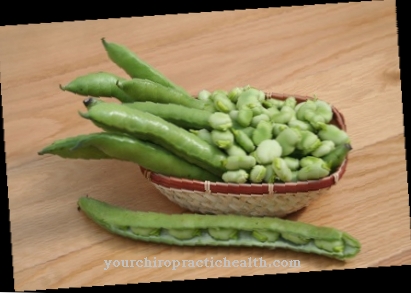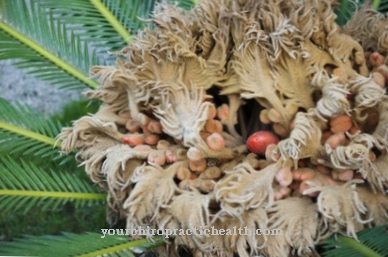Green kernels is the semi-ripe harvested spelled grain. The grain is also under the name Baden rice known.
What you should know about green kernels

Green spelled comes from the spelled plant. The spelled is a grain and belongs to the genus wheat. It is closely related to today's wheat. There are many mixed forms between wheat and spelled.
In many regions of Germany, both wheat and spelled are grown and crossed with one another. There are various theories about the origin of spelled. It is believed that the grain originated from a cross between emmer and common wheat. However, the spelled may also have developed through a mutation of the ancient grain variety Einkorn.
Spelled is a very old type of grain. The oldest finds appeared in western Georgia. Spelled was grown here apparently as early as the 5th millennium BC. Millennia-old spelled has also been found in Bulgaria, Romania, southern Sweden and Denmark. In the Neolithic Age, spelled grain was mainly grown in Northern and Central Europe. As early as 1700 years before the birth of Christ, the cultivation of spelled spread in what is now German-speaking Switzerland. Place names like Dinkelsbühl or Dinkelscherben indicate the earlier meaning of the spelled. In the 18th century, spelled finally became one of the most important commercial grains.
Spelled is usually harvested in late August or early September. Since the field workers in the 17th and 18th centuries were also dependent on nutrient-rich food in summer, parts of the spelled were harvested when they were not ripe. The spelled is still green in summer, so that the name Grünkern caught on for the spelled parts that were harvested early. However, the green spelled cannot be stored in immature form. It would spoil way too quickly. That is why green spelled is kilned. In the kiln, food is dried with the help of heat. The drying process has been known since prehistoric times. Traditionally, green kernels are kilned over a beech wood fire.
Today, however, the drying process usually takes place in hot air systems. After drying, the green spelled contains only 13 percent moisture. It now has a much longer shelf life and has developed its typical hearty, nutty aroma. However, before further processing, the green spelled must be freed from its husks. The green spelled husks are mostly used as fodder.
In Germany today, green kernels are mainly cultivated in building land in northern Baden. This is where the well-known "Franconian Grünkern" is produced. Many dishes that are made with green spelled are now regional cultural assets.
Importance to health
Even the holy Hildegard von Bingen knew to appreciate the health-promoting properties of the spelled and thus also the green core. She recommended consuming spelled daily and was of the opinion that spelled made people happy and healthy. In fact, spelled contains more vitamins and minerals than wheat, for example.
It is also easier to digest and therefore also suitable for people with digestive problems. Green spelled contains the amino acids BCAA and tryptophan. BCAA are the so-called branched chain amino acids. These are branched-chain amino acids such as leucine, isoleucine and valine. These play an important role in building and maintaining muscle. Tryptophan is required for the formation of serotonin. Serotonin is the so-called "happiness hormone".
Ingredients & nutritional values
Green spelled is one of the healthiest types of grain. It is rich in vitamins and minerals and also contains less starch than mature spelled. 100 grams of green spelled contains:
- 324 calories
- 2.7 grams of fat
- 12 grams of protein
- 9 grams of fiber
- 64 grams of carbohydrates
It is worth mentioning the high content of B vitamins. In particular, folic acid and niacin equivalents are contained in large quantities. Green spelled also contains significantly more vitamin E than rye or wheat, for example. In addition, green kernels are rich in potassium, phosphorus, copper, manganese, sulfur, zinc, chloride, fluoride, sodium and calcium. A high content of silica is also a characteristic of the green core.
The protein content of the green core is also considerable. With the exception of the amino acid lysine, green spelled contains all essential amino acids. Spelled and therefore green spelled also show a lower level of radioactive pollution than other types of grain. The husk shell of the spelled protects the grain from harmful influences from the environment.
Intolerances & allergies
Many people with stomach problems are sensitive to grains. In the case of green spelled, however, stomach problems usually do not occur. The grain is also well tolerated by people with sensitive stomachs.
Allergies to grains are quite common. Most of the time, however, the allergy is more related to wheat. An allergy is triggered by various protein components such as globulin, gluten or albumin. Albumin and globulin are found primarily in the outer shell of the spelled grain, while gluten is in the endosperm.
Celiac disease is not just an allergy, but a gluten intolerance. The consumption of foods containing gluten causes inflammation of the intestinal mucosa in those affected. This destroys the cells of the intestinal mucous membrane and there are absorption disorders with subsequent nutrient deficiencies. Symptoms such as weight loss, diarrhea, loss of appetite, vomiting or depression also appear. If you have celiac disease, eating all cereal products that contain gluten leads to inflammation. This means that greens can also trigger complaints. People with celiac disease should therefore avoid greens.
Shopping & kitchen tips
Green spelled is only harvested in June and July, but is available in the dried form all year round. A high quality green seed has an olive green color.
Brown green spelled, on the other hand, is considered inferior and should therefore not be bought. Green spelled is commercially available in the form of grains, pearl barley, semolina, flakes, flour and meal. Whole green spelled grains can be kept for two to three years in dry, airtight packaging. Flakes and flour can oxidize quickly and lose their valuable nutrients. They should therefore be processed as quickly as possible.
Preparation tips
The whole grains, pearl barley and flakes are easy to process into patties or dumplings. Vegans and vegetarians like to use these as a hearty meat substitute. The patties taste good as an accompaniment to potatoes or vegetables. The green spelled dumplings can also be used as a soup. Green kernels taste good in casseroles or mueslis. Since the protein structures of the green kernel are damaged during kilning, green kernel flour can only be used for baking in combination with other flours containing gluten.
The basic recipe for preparing the green spelled grains is simple. The grains must first be rinsed thoroughly in a sieve. Then you should cook with twice the amount of liquid for ten minutes over high heat. Then cover the grains for half an hour. Alternatively, the green spelled can be soaked in cold water overnight. The cooking time is then reduced to ten minutes. With this gentle preparation variant, more vitamins and minerals are retained.

























.jpg)

.jpg)
